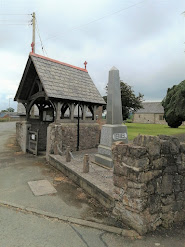 |
| The Old Malthouse, Atcham |
A blog for those interested in the war memorials of Shropshire and Mid Wales. Please scroll down the page - there are many different posts to choose from. If you would like to make contact (or purchase a copy of my book 'Sites of Remembrance' at £14.95 with free p&p) I would pleased to hear from you. My email address is peterjohnfrancis@googlemail.com. Thanks.
Wednesday 5 October 2022
The Old Malthouse
Friday 17 June 2022
Disaster at Sheerness
The small village of Llandrinio in Montgomeryshire lies close to the border with Shropshire about nine miles north of Welshpool. Its war memorial is a striking marble obelisk standing next to the church lychgate. Listed on it are 17 local men who, “gave their lives fighting for the cause of freedom in the Great War”. At the top is the name of Stuart Ford Moorhouse of the Royal Navy who died on 26th November 1914 whilst serving aboard HMS Bulwark.
 |
| Llandrinio war memorial |
She was one of five London-class battleships built for the Royal Navy at the end of the 19th century. Completed in 1902, she was initially assigned to the Mediterranean Fleet and then served with the Channel and Home Fleets from 1907 to 1910, usually as a flagship. Following the start of the First World War, Bulwark was attached to the Channel Fleet to protect the British Expeditionary Force as it moved across the English Channel to France. At about 07;53 on 26th November 1914, a huge internal explosion ripped Bulwark apart while she was moored a few miles west of Sheerness in the estuary of the River Medway. All the ship's officers were killed in the explosion and only a dozen ratings survived. A total of 741 men were lost including members of the band of the gunnery school, HMS Excellent, which was playing aboard. Only about 30 bodies were recovered after the explosion.
 |
| Explosion aboard HMS Bulwark |
A naval court of enquiry, held only two days later, concluded that the disaster was probably caused by the overheating of about 30 cordite propellant charges that had been placed adjacent to a boiler-room bulkhead. The bulkhead was increasing in temperature as the boilers were fired up and this ignited the cordite charges which in turn detonated hundreds of six-inch and twelve-pounder shells stored nearby.
Sunday 13 February 2022
Shrewsbury School Old Boys' memorial
 |
| Shrewsbury School |
In 1948 a low stone wall was erected, partly surrounding the Sidney memorial, inscribed with the names of Old Salopians who died during the Second World War.
Shrewsbury School war memorial

